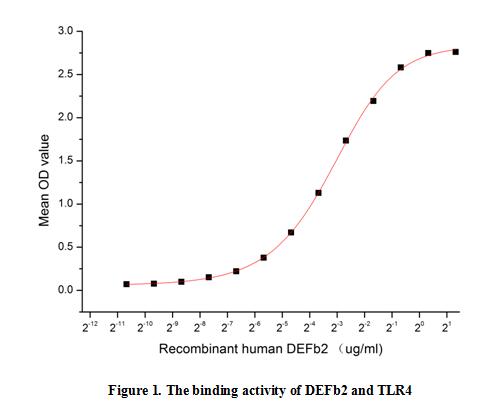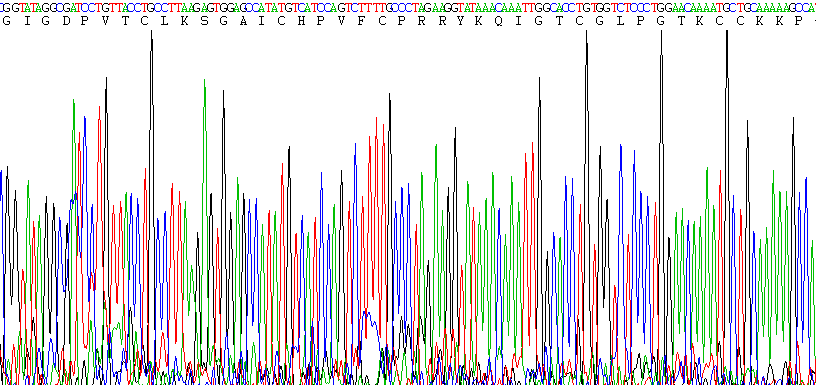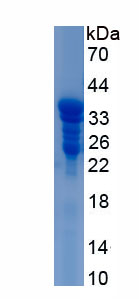Active Defensin Beta 2 (DEFb2) 

B-DF2; DEFB2; BD2; DEF-B2; HBD2; DEFB102; HBD-2; SAP1; DEFB4A; DEFB4; Skin-Antimicrobial Peptide 1
- UOM
- FOB US$ 216.00 US$ 540.00 US$ 1,080.00 US$ 3,240.00 US$ 8,100.00
- Quantity
Overview
Properties
- Product No.APA072Hu01
- Organism SpeciesHomo sapiens (Human) Same name, Different species.
- ApplicationsCell culture; Activity Assays.
Research use only - DownloadInstruction Manual
- CategoryInfection immunity
- Buffer FormulationPBS, pH7.4, containing 0.01% SKL, 5% Trehalose.
- Traits Freeze-dried powder, Purity > 80%
- Isoelectric Point8.0
Sign into your account
Share a new citation as an author
Upload your experimental result
Review

Contact us
Please fill in the blank.
Activity test

Defensin Beta 2 (DEFb2) is a 7 kDa secreted protein. It exhibits antimicrobial activity against Gram-negative bacteria and Gram-positive bacteria, with highest activity against Gram-negative bacteria. Antimicrobial activity against P.aruginosa seems to be salt-sensitive and is reduced with high salt concentrations greater than 25 mM. The human DEFb2 cDNA encodes a 64 aa protein with a 23 aa signal sequence and a 41 aa mature sequence. Besides, Toll Like Receptor 4 (TLR4) has been identified as an interactor of DEFb2, thus a binding ELISA assay was conducted to detect the interaction of recombinant human DEFb2 and recombinant human TLR4. Briefly, DEFb2 was diluted serially in PBS with 0.01% BSA (pH 7.4). Duplicate samples of 100μl were then transferred to TLR4-coated microtiter wells and incubated for 1h at 37℃. Wells were washed with PBST and incubated for 1h with anti-DEFb2 pAb, then aspirated and washed 3 times. After incubation with HRP labelled secondary antibody for 1h at 37℃, wells were aspirated and washed 5 times. With the addition of substrate solution, wells were incubated 15-25 minutes at 37℃. Finally, add 50µL stop solution to the wells and read at 450/630nm immediately. The binding activity of DEFb2 and TLR4 was shown in Figure 1, the EC50 for this effect is 0.11 ug/mL.
Usage
Reconstitute in 10mM PBS (pH7.4) to a concentration of 0.1-1.0 mg/mL. Do not vortex.
Storage
Avoid repeated freeze/thaw cycles. Store at 2-8°C for one month. Aliquot and store at -80°C for 12 months.
Stability
The thermal stability is described by the loss rate. The loss rate was determined by accelerated thermal degradation test, that is, incubate the protein at 37°C for 48h, and no obvious degradation and precipitation were observed. The loss rate is less than 5% within the expiration date under appropriate storage condition.
Increment services
-
 BCA Protein Quantification Kit
BCA Protein Quantification Kit
-
 Molecular Mass Marker for Protein
Molecular Mass Marker for Protein
-
 Monoclonal Antibody Customized Service
Monoclonal Antibody Customized Service
-
 Polyclonal Antibody Customized Service
Polyclonal Antibody Customized Service
-
 Protein Activity Test Experiment Service
Protein Activity Test Experiment Service
-
 Electrophoretic Mobility Shift Assay (EMSA) Experiment Service
Electrophoretic Mobility Shift Assay (EMSA) Experiment Service
-
 Buffer
Buffer
-
 Lentivirus Packaging Experiment Service
Lentivirus Packaging Experiment Service
-
 Adenovirus Packaging Experiment Service
Adenovirus Packaging Experiment Service
-
 Real Time PCR Experimental Service
Real Time PCR Experimental Service
-
 Spike RBD Protein (S-RBD)
Spike RBD Protein (S-RBD)
-
 Protein G
Protein G
-
 Protein A
Protein A
Citations
- The effect of Lactobacillus on the expression of porcine β-defensin-2 in the digestive tract of pigletsScienceDirect: S1871141311000126
- Modulation of Porcine β-Defensins 1 and 2 upon Individual and Combined Fusarium Toxin Exposure in a Swine Jejunal Epithelial Cell LineAsm: Source
- HIF-1α Is Essential for Effective PMN Bacterial Killing, Antimicrobial Peptide Production and Apoptosis in?Pseudomonas aeruginosa?KeratitisPubMed: PMC3715414
- Identification of sociodemographic and clinical factors associated with the levels of human β-defensin-1 and human β-defensin-2 in the human milk of Han ChinesePubmed: 24124699
- The Assessment of Vitamin D, Antimicrobial Peptides and Procalcitonin in BronchiectasisWaikato:Source
- On birth single dose live attenuated OPV and BCG vaccination induces gut cathelicidin LL37 responses at 6 week of age: A natural experimentPubmed:25444792
- Concentration characteristics of bovine β-defensin 1 and 2 in fresh bovine milk and infant formulaDoi: 10.1111
- Green tea polyphenol epigallocatechin-3-gallate improves epithelial barrier function by inducing the productionof antimicrobial peptide pBD-1 and pBD-2 in monolayers of porcine intestinal epithelial IPEC-J2 cells.Pubmed:26991948
- Vitamin D and allergic airway disease shape the murine lung microbiome in a sex-specific manner.pubmed:27655266
- The Level of Inflammatory Cytokines and Antimicrobial Peptides after Composite Material Implantation and Contamination with Bacterial Culture.16629795
- Measurements of AMPs in stratum corneum of atopic dermatitis and healthy skin–tape stripping techniquePubmed:29374283
- Swine-Derived Probiotic Lactobacillus plantarum Inhibits Growth and Adhesion of Enterotoxigenic Escherichia coli and Mediates Host DefensePubmed:29997590
- Glyoxal-induced exacerbation of pruritus and dermatitis is associated with staphylococcus aureus colonization in the skin of a rat model of atopic dermatitisPubmed:29496360
- Caprylic acid and nonanoic acid upregulate endogenous host defense peptides to enhance intestinal epithelial immunological barrier function via histone deacetylase …Pubmed: 30342347
- Influence of Antibiotic-Impregnated Biomaterials on Inflammatory Cytokines
- Bovine fetal mesenchymal stem cells exert antiproliferative effect against mastitis causing pathogen Staphylococcus aureusPubmed: 30975214
- Damage-Associated Molecular Patterns and Myeloid-Derived Suppressor Cells in Bronchoalveolar Lavage Fluid in Chronic Obstructive Pulmonary Disease Patients
- Toll-like receptor 5-mediated IL-17C expression in intestinal epithelial cells enhances epithelial host defense against F4+ ETEC infectionPubmed: 31221216
- Fat Encapsulation Reduces Diarrhea in Piglets Partially by Repairing the Intestinal Barrier and Improving Fatty Acid Transport33375218
- Human beta defensin levels and vaginal microbiome composition in post-menopausal women diagnosed with lichen sclerosus34362937
- Regulatory T cells, damage-associated molecular patterns, and myeloid-derived suppressor cells in bronchoalveolar lavage fluid interlinked with chronic obstructive …Pubmed:35687771









